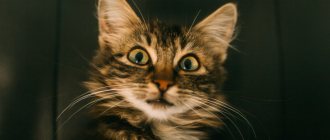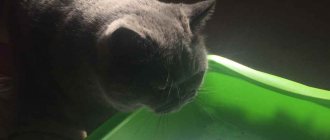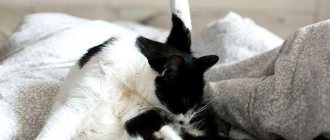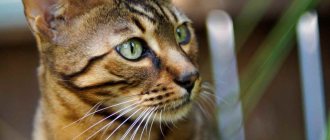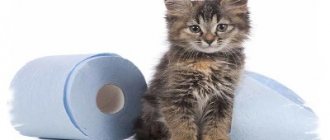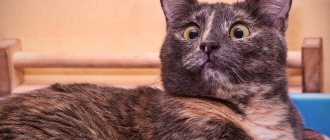Home » Useful Information
Increased salivation in cats can appear for completely harmless reasons, but in some cases the provocateur becomes a pathology that requires mandatory treatment. When such a clinical picture occurs, competent differential diagnosis is important, which will help to identify the disease in the pet at the initial stage.
- 2 Causes of hypersalivation
2.1 The main causes of hypersalivation in cats - video
- 4.1 Drugs that are used to eliminate the causes of hypersalivation - photo gallery
Oral problems
Dental disease is the usual explanation. In such cases, cats drool to soothe irritation in the mouth or throat.
If swallowing is painful, your cat may drool from the mouth. Your cat may avoid food due to pain when swallowing or eating. Common causes of mouth pain in cats include:
- Dental disease (gingivitis)
- Tumors or ulcers in the mouth
- Broken tooth
- Foreign body under the tongue
- Exposure to toxic chemicals
- Recent interactions with a toxic plant
- Trauma, damage. For example, if your cat chews on an electrical cord and gets electrocuted.
Drooling may be accompanied by other symptoms such as:
- Halitosis (bad breath)
- Weight loss
- Loss of appetite
- Lack of interest in solid foods
- Throwing away food while eating
According to the Canadian Veterinary Medical Association, feline resorptive lesions (FORL), neckline erosions, internal or external root resorptions and neck lesions commonly lead to dental disease in cats, which can cause severe drooling and oral pain.
Functions of saliva
Saliva is a secretion that can be watery if it comes from the serous glands, or viscous if it comes from the mucous glands. It contains up to 99.5% water. In addition, the composition includes:
- electrolytes – anions and cations;
- proteins in small quantities;
- mucin
Saliva performs the following functions:
- protects teeth, gums and oral mucosa from damage;
- softens food, makes it easier to chew food;
- extracts flavor elements from food;
- helps the formation of a food coma, which is easier to swallow;
- is able to disinfect and stop bleeding due to the presence of thromboplastic components in the composition.
Respiratory diseases
Viral respiratory diseases can lead to ulcerations in your cat's mouth. This may cause mouth pain and increased salivation. Cats that live in shelters or multi-cat homes have a higher risk of respiratory infections.
The veterinarian must treat infections. However, you can take steps to prevent your cat from becoming infected. Some of these include keeping your cat indoors, ensuring up-to-date vaccinations, limiting interactions with other pets, and washing your hands after handling other animals.
Diagnostic methods
A complete diagnosis in a veterinary clinic helps to establish the causes of the disease. It helps to determine a possible pathology:
- history taking, examination;
- general, clinical analysis of blood, feces, urine;
- performing ultrasound, radiography, MRI.
Modern research methods make it possible to determine the condition of internal organs, study the functioning of the digestive system, determine the presence of helminthic infestation, trichobezoars, and possible injuries. The animal should be prepared for a number of procedures. For example, to conduct an ultrasound of the gastrointestinal tract, you should not feed for 10 hours.
Kidney failure
Kidney failure can manifest itself in acute or chronic conditions. Cats with chronic renal failure (CRF), also called chronic kidney damage, often exhibit clinical signs of increased thirst, weight loss, dilute urine, increased urination (manifested as large collections in the litter box), halitosis, and drooling. .
This condition occurs when the kidneys are unable to remove waste products, creatine and BUN from the body. As these wastes accumulate in the bloodstream, they create uremic ulcers in the stomach, mouth, and esophagus. A veterinarian often treats kidney disease by:
- Medicines
- Intravenous fluids
- Blood work monitoring
- Stomach protection
- Low protein diet
The cat's drool flows like clear water, in drops
With increased salivation, the cat has a wet chin, throat, and fur. The cat often swallows saliva, rubs its face on furniture, and washes itself excessively. Long hair gets matted into icicles. The litter becomes covered with wet spots. This may indicate other problems. Manifestations of excessive salivation are a manifestation of an illness that needs to be identified as early as possible. Among cat diseases, clear drooling corresponds to most diseases except rabies.
With rabies, salivation will flow foamy, but this can also happen after taking a bitter medicine. When a cat has rabies, he drinks little, goes to dark places, avoiding bright light, as it contributes to eye pain. During this period, the cat falls into an aggressive or apathetic state. This is lethal for a cat, but the animal can also infect a person through a bite, and this can have a bad effect on human health. Therefore, if saliva comes out in the form of foam, you should find out about the nature of the disease from a veterinarian.
Ingestion of a foreign object
If your cat ingests something unpleasant or toxic, one of the first reactions may be drooling. Sometimes the toxin entering the body can also cause oral erosion, which can also lead to drooling.
Swallowing a thread with a needle attached or a foreign body that can become lodged in the tongue, back of the throat, or soft or hard palate can cause oral pain and drooling.
Your cat may also have difficulty closing his mouth. If a foreign body, such as a fish bone, gets stuck in the esophagus, the saliva has nowhere to go. It will begin to accumulate in the cat's esophagus and pour out of the mouth.
© shutterstock
If you notice a rope hanging from your cat's mouth, do not try to remove it. The thread can wrap around vital organs such as the stomach or intestines. Pulling can cause significant permanent damage.
If swallowing is uncomfortable, your cat may put her paw on her mouth and try to vomit. The inability to swallow properly can cause cats to have a lack of appetite and unexplained weight loss.
Causes
The reasons for salivation can be very diverse. The above lists natural irritants that will not cause any particular inconvenience to the cat and will not affect his health in any way. Otherwise, the release of clear saliva is a sign of improper functioning of the animal’s body, which can have unpleasant consequences.
© shutterstock
The only good news is that a large amount of clear saliva is not a sign of rabies. This disease has no cure and is fatal, and if your pet catches it, the saliva will look like foam. The cat will be afraid of the light, become more aggressive or, on the contrary, affectionate and behave unnaturally.
Caustic poisons
Cats cannot metabolize chemicals and medications well. This is due to their altered metabolism in the liver, called glucuronidation.
Corrosion from chemicals (washing detergents, floor cleaners, weed killers, etc.) can cause burns to the mouth, tongue, esophagus and stomach. If swallowed, they can cause poisoning and severe drooling.
If you suspect that your cat has recently been exposed to a caustic chemical, you should rinse her mouth with water. After rinsing, offer your cat something she will enjoy drinking, such as chicken broth. This will flush the esophagus and loosen the toxin in the mouth.
Treatment of pathologies associated with the symptom
If increased salivation is caused by physiological factors, then no special treatment is provided. Psychological and pathological causes require mandatory therapy. What treatment methods are used depending on the factor:
- If the cause is nervous overstrain, cats are usually prescribed sedative medications: Stop Stress, Fitex, etc. Such drugs help eliminate the effects of stress. The course of treatment often does not exceed 7–14 days. Stop Stress is usually given 1 tablet per day or 1 drop per 1 kg of weight, and Fitex 3-5 drops per day. The exact dose is determined by the doctor. In addition, it is important to provide the pet with peace and surround it with affection and care.
- For diseases of the oral cavity, anti-inflammatory drugs are used, such as Dentavedin gel, Zubastik spray, etc. These drugs eliminate swelling of the gums and have an antiseptic and healing effect. Gel Dentavedin contains bee products, chlorhexidine and medicinal plants. It should be applied 2-3 times a day to the gums for 5-7 days. Zubastic spray also contains plant extracts and an enzyme anti-inflammatory complex. The medicine is irrigated into the mouth several times a day for a week.
- If a cat has a bone or other foreign object stuck in its throat or teeth, it must be removed in a veterinary clinic. For these purposes, the doctor can use tweezers or an endoscope. Immediately after removing the foreign body, hypersalivation stops. It is dangerous to independently remove a bone stuck in the larynx, as you can push it further or injure your pet (especially when using tweezers).
- If the cause is the rabies virus, which was diagnosed in the laboratory, then, unfortunately, the pet is euthanized. This disease is incurable and dangerous not only for animals, but also for people. Therefore, if rabies is suspected, the cat is quarantined until a diagnosis is made.
- In case of poisoning, the pet is prescribed adsorbents such as activated carbon. The tablet must be crushed into powder and dissolved in 1 tsp. water, then forcefully pour it into your pet’s mouth. However, if the intoxication is severe, then urgent hospitalization is required, which includes gastric lavage. In addition to adsorbents, the animal should be given 20 ml of water every hour from a syringe without a needle if it does not drink on its own. This procedure will prevent dehydration.
- If the provoking factor for hypersalivation is helminthic infestations, anti-helminth medications are prescribed, such as Prazicide, Drontal, etc. In most cases, a single application is enough to rid your furry friend of parasites. The dose should be calculated based on the cat's body weight.
- The presence of tumors requires treatment only in a hospital setting. In this case, they resort to surgical intervention, which is aimed at excision of the tumor. Additionally, medications may be prescribed: Metastop, Cytostat, etc. The first drug prevents the growth of tumors and reduces the risk of metastases, and also has an antitoxic effect. Cytostat improves the overall well-being of the pet. Additionally, it has an antioxidant and antitoxic effect, accelerating recovery.
- If the provocateur of increased salivation is an allergic reaction, then drug therapy is prescribed. For anaphylactic shock, glucocorticosteroids are indicated. They are also used for severe allergic reactions, which are accompanied by severe itching. The most commonly prescribed drugs are Dexamethasone and Prednisolone, which are administered intramuscularly. A single dose ranges from 0.1 to 0.5 ml. The exact amount of solution and course are determined only by the doctor, since steroid drugs can cause dangerous side effects.
- To eliminate mild allergy symptoms, classic antihistamines are used: Suprastin, Zodak, Cetirizine, etc. They are usually given to the pet orally, a quarter of a tablet, once a day. The course is determined by the doctor. It is important to identify the allergen and eliminate it. Otherwise, after stopping therapy, the symptoms will return again.
- Calcivirosis can be eliminated with the help of complex treatment. When bacterial flora attaches, which happens in most cases, the pet is prescribed antibiotics (Tetracycline, Amoxicillin). Additionally, they resort to intravenous infusion of physiological solutions, as well as vitamin therapy. Anti-inflammatory medications such as Levomekol are used. The ointment is applied to the affected areas several times a day. To speed up recovery, immunostimulants are prescribed: Imunofan, Fosprenil, etc. The course of treatment depends on the severity of symptoms and is determined only by a doctor.
If the cause is inflammatory diseases of the gastrointestinal tract, then the cat is prescribed a gentle diet. Your pet's diet should be free of fatty, smoked and salty foods. At the same time, food is selected for sensitive digestion. It is advisable to give preference to reputable brands such as Royal Canin, Arden Grange, Pro Plan, etc. There are special lines for pets with digestive problems:
- Royal Canin Sensible 33;
- Arden Grange Sensitive;
- Pro Plan Delicate.
Royal Canin Sensible 33 is designed for pets with sensitive digestion
Attention! Without prior consultation with a doctor, you should not resort to drug therapy, especially potent drugs, which, if used incorrectly, can only cause harm.
My cat always drooled after I gave her any medicine. At first it seemed to me that the drug was toxic, which is why I had this reaction. I thought that I only made the pet worse with this treatment. It turns out that increased salivation is a normal reaction to bitters in cats. Hypersalivation is also observed when you squeeze and pet an animal excessively. According to the veterinarian, there is nothing wrong with this.
Drugs that are used to eliminate the causes of hypersalivation - photo gallery
Stop Stress has a calming effect
Activated carbon helps remove and bind toxic substances Drontal helps remove helminths
Dexamethasone eliminates acute allergic reactions Zodak relieves allergy symptoms Metastop has antitumor properties Dentavedin has an anti-inflammatory effect
Fosprenil accelerates recovery from calcivirosis
Poisonous plants
According to Mark S. Thompson, plants containing insoluble calcium oxalate crystals can cause a severe burning sensation in the mouth if your cat accidentally ingests them. Plants that are poisonous to cats include:
- Peace Lily
- Calla Lily
- elephant ear
- Dieffenbachia
- umbrella plant
- mother in law tongue
Insoluble calcium oxalate in plants causes minimal toxicity in cats, but can cause unpleasant reactions. If you have one of these plants and you suspect a cat has gotten into it, rinse its mouth with water and then give the broth.
Normal salivary processes
A cat's salivation can be a natural occurrence. This liquid protects the gums, teeth, and oral mucosa from damage. It facilitates chewing food, swallowing processes, has a bactericidal effect and performs other functions. Saliva contains lysozyme, which accelerates tissue regeneration and has an anti-inflammatory effect.
Salivation should not be a concern in the following cases:
- while eating food;
- if the animal smells or sees food;
- while chewing food;
- with severe nervous stress;
- when taking bitter medications (for worms, no-shpa and others).
Salivation increases slightly if the cat is healthy. You can see saliva on the fur near the mouth. If there is a large volume of saliva or its release for more than 10-15 minutes, the owner of the animal should be concerned.
Doctors refer to the process of salivation as “salivation.” Do not be alarmed if your doctor diagnoses ptyalism or hypersalivation. These terms simply mean that the animal is drooling more than usual from its mouth.
Emotional Stimuli
Cats drool when they are excited, scared or anxious. If your cat is nauseous, worrying about vomiting may lead to drooling.
For example, cats are rarely driven in cars unless they are being taken to a veterinarian. Such trips can bring back bad memories for your cat and make her feel apprehensive and nauseous. Signs of anxiety in cats include open-mouth breathing and panting.
Some cats drool when they are calm and relaxed or when they enjoy being cuddled or rubbed. This is common in cats and is a physiological response to feeling happy. Sometimes cats drool while sleeping, again because they are very relaxed. This drooling often indicates that the cat is feeling comfortable.
© shutterstock
Consequences of self-medication
Lost time to provide assistance often causes complications and sometimes death of pets.
Most diseases do not go away on their own. It is necessary to treat with medications, the selection and dosage of which is prescribed only by a specialist. Inflammatory processes without proper attention shorten life. So, without treatment, gingivitis becomes chronic, the cat loses teeth, and digestion is impaired. Pain and frustration spoil the character of the animal.
The entry of foreign objects into the stomach and intestines leads to necrosis and tissue rupture. Waiting for the cat to get rid of the load on its own is dangerous.
Visiting the Veterinarian
Increased drooling is not always a harmless phenomenon. It is not always possible to cope with the problem without the help of a doctor.
Injury
Trauma to the mouth can cause excessive drooling. Oral injuries can occur if a cat bites through an electrical cord and suffers a burn to the mouth. If your cat has recently gotten into a fight with another cat, any trauma to the mouth, such as a broken jaw, may cause drooling.
Keeping a cat indoors reduces the chance of injury from being hit by a car or attacked by a rival cat for territory. An injury to a dislocated temporomandibular joint or a fractured jaw can lead to excessive drooling due to the cat's inability to close its mouth.
If you suspect your cat is drooling due to an oral injury, a thorough oral examination and x-rays may be required to make an accurate medical diagnosis.
Prevention measures
It is easier for a sensitive owner to prevent many problems by being attentive to the pet. Veterinarians recommend:
- monitor the cat's diet;
- exclude bones from the diet;
- carry out timely antiparasitic treatments;
- comb out pets' fur during shedding;
- use special toys to clean your cat's teeth;
- follow vaccination schedules;
- remove household chemicals from pets;
- monitor the condition of your teeth and mouth.
Prevention of cat diseases is directly related to regular visits to the veterinarian. The appearance of excessive saliva in a pet is a serious reason to examine the animal.
Heatstroke
Flat-faced cats, such as Persians, have a higher risk of heatstroke, which can cause drooling. Although heatstroke is not as common in cats, too much time in the sun or not drinking enough water can have detrimental effects.
Cats love the sun. Always have fresh, clean water on hand. In the summer, make sure your cat has shady places to cool off. Keep your cat indoors on hot days. Never leave a cat in a parked car. Limit training and play time to keep your cat from overheating.
Signs of excessive drooling
The presence of food or any irritant in the cat's mouth causes the production of saliva. Sometimes increased secretion of glands occurs for other reasons. You can notice the manifestation of drooling by characteristic factors in your pet’s behavior:
- often rubs its muzzle on the corners of furniture to get rid of accumulated excess;
- the cat often swallows and rubs its muzzle with its paw;
- The pet's tongue seems to fall out of the mouth and becomes flaccid.
Cat drooling
Drools flow in different ways:
- actively in streams or drops;
- slowly, imperceptibly at first glance.
An observant owner will notice the appearance of dampness in the places where the animal sleeps, the accumulation of wet fur, “icicles” on the pet’s neck and paws.

